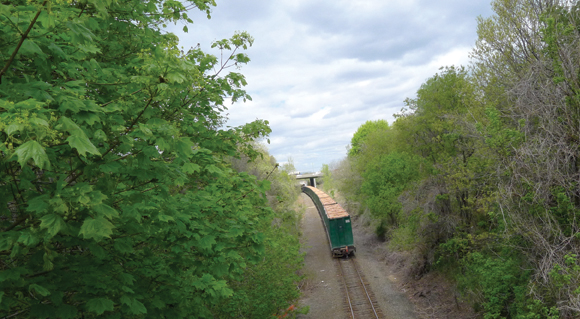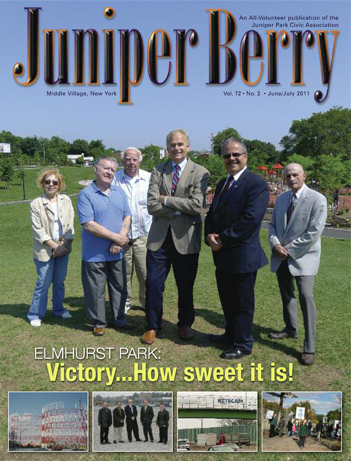Through the years it involved dumping everything into a big hole and covering it up. That worked pretty good when the population involved fewer people and people in general consumed a lot less. For thousands of years native inhabitants lived close to the earth on these lands. They hunted, fished and grew crops, their only remnants are some clay pots, clamshells and arrowheads, and all other materials have gone back to nature. Compare that today when most things we use will be around for long after we are gone. Think of all our possessions such as TV’s, books, records and CD’s, our furniture, the family car and so much more.
Land filling began in lower Manhattan with the Dutch when it was called New Amsterdam in the 1600s and spread from there. Every borough has had large areas filled in with garbage. The Corona dumps are mentioned in the book the “Great Gatsby” as an ash heap in the 1920s and this became Flushing Meadow Park, in time for the World’s Fair in 1939. Much of Newtown Creek and its tributaries, which stretched all the way to Flushing, were filled in the 1800s. Maspeth began where the Newtown Creek ended; it became the Maspeth Town Dock right near where Saint Savior’s once stood. From 1965-1991 there were 6 major landfills filled to capacity leaving only Fresh Kills in Staten Island, which was closed in 2001 when it had the title of the biggest dump in the U.S.A. They say that Fresh Kills is one of only two man-made objects that can be seen from space, the other is the Great Wall of China and the highest point of land on the Eastern Seaboard. Fresh Kills is now being converted into a park and will be one of the biggest parks in the city, it will open in a few years.
Another popular way to dispose of trash back in the day was to burn it. The Native Americans set the woods on fire to clear land for hunting and farming and European settlers continued with this practice. I can even remember when my family in Port Jefferson on Long Island burned their trash in the 1960s but there are far fewer places now where this is allowed. New York City opened its first incinerator on Governors Island in the 1880s and over the years built 22 incinerators that also generated electricity. Sounded like a good idea until people started noticing that the fumes from burning all that garbage was full of chemicals that weren’t too good for people to be breathing. The residue ash was also toxic and that had to be dumped somewhere. I can remember as a boy growing up in the ‘60s when the ash would fall like snow flakes and when I would talk to people from Greenpoint, they said the same thing. In 1964 there were 11 incinerators, 1972 there were 7, 1990 there were 3 and by 1990 they were all shut down.
Much of the trash was dumped into the East River and when it became unsanitary and unsightly this practice was stopped. So it made sense that since we were so close to the ocean to just dump it and allow it to dissipate so the currents could take it away. By the 1880s about 75 percent was dumped in the ocean and, since that was becoming a mess, ocean dumping of trash stopped in 1895. The city began a recycling program that mandated garbage be put into 3 categories: 1- food waste which was used for fertilizer, 2-rubbish which could be recycled into paper, 3- things that couldn’t be recycled were turned into ash and were land filled.
World War I ended the recycling program because of labor shortages and ocean dumping was reinstated. During World War II there were shortages of materials because of the war effort, so people saved everything and valuable resources were collected. I can remember in the ‘50s and ‘60s people would drive around and collect newspapers and scrap metal. We called these people the “Junk Men.” My father told me when he was a boy he remembers the junk man had a horse and wagon in Maspeth so garbage has always had value.
Up to the1960s most soda and beer bottles were returned to the store and they could be turned in for cash. The beverage industry changed its practice of reusing bottles, often 20 times or more, to the disposable bottle. This added quite a bit of garbage to the solid waste pile and with the growing litter problem environmentalists were becoming alarmed at the garbage problem. Oregon became the first state in 1971 to adopt the Bottle Law, New York joined in 1983 and today there are 11 states participating. Last year New York adopted the Bigger Bottle Law and expanded it to include water bottles, proponents wanted all juice, ice tea and sports drinks included but couldn’t get the legislation passed.
New York passed the Solid Waste Management Act in 1988 and gave municipalities until 1994 to adopt a recycling program. Environmentalists have been pushing for more types of plastic materials to be collected as well as reinstating the collection of leaves, a huge amount with the millions of trees in New York, and the leaves can be used for compost in our parks and gardens. Since we have such a good recycling program I would like to see an end to the Bottle Law, it seems like such a waste of energy and an inconvenience to consumers and businesses which I’d like to discuss further in another article.
When New York closed its last landfill in 2001 the only solution it had was to truck the garbage out of state to Pennsylvania, Ohio and Virginia which created lots of truck traffic and air pollution. The latest plan calls for waste transfer stations where it can be put on barges and loaded onto trains which has given us a new set of problems with the trains disturbing people with the noise and fumes of the trains and the stink of the garbage.
As a society we have come a long way with a great Sanitation Department that takes our garbage and recyclables. We now have battery and oil reclaiming at service centers. Gone are the days when people changed their oil from their car and dumped it in the sewers thus polluting our waterways. In the last 50 years since the Clean Water Act was passed industrial waste and raw sewage are not routinely dumped into our waterways and we have seen a great improvement in our water quality.
We still have those who would rather throw a bag on the side of the road or leave their household trash on the corner basket. I would like to see recycling bins on our streets, parks and beaches. Right now our schools are not set up for recycling and we should be teaching our young how important it is to reuse, to refuse (trash) and to recycle if we ever want to get a handle on the problems of garbage.




